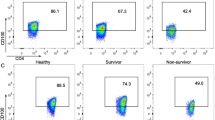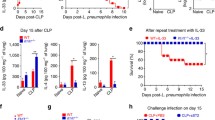Abstract
Purpose
Sepsis syndrome represents the leading cause of death in intensive care unit. Patients present features consistent with a decline in immune responsiveness potentially contributing to mortality. We investigated whether CD4+CD25+ regulatory T cells (Treg) participate in the induction of lymphocyte anergy after sepsis.
Method
Observational study in septic shock patients and experimental study in mice.
Results
We took advantage of the recently described flow cytometric gating strategy using the measurement of CD25 and CD127 expressions for monitoring Treg (CD4+CD25+CD127−Foxp3+). In patients the increased circulating Treg percentage significantly correlated with a decreased lympho-proliferative response. In a murine model of sepsis mimicking these observations, the ex vivo downregulation of Foxp3 expression using siRNA was associated with a restoration of this response.
Conclusion
The relative increase in circulating Treg might play a role in lymphocyte anergy described after septic shock and represent a standardizable surrogate marker of declining proliferative capacity after sepsis.




Similar content being viewed by others
References
Brun-Buisson C, Meshaka P, Pinton P, Valley P, EPISEPSIS Study group (2004) EPISEPSIS: a reappraisal of the epidemiology and outcome of severe sepsis in French intensive care units. Intensive Care Med 30:580–588
Brun-Buisson C, Roudot-Thoraval F, Girou E, Grenier-Sennelier C, Durand-Zaleski I (2003) The costs of septic syndromes in the intensive care unit and influence of hospital-acquired sepsis. Intensive Care Med 29:1464–1471
Angus DC, Linde-Zwirble WT, Lidicker J, Clermont G, Carcillo J, Pinsky MR (2001) Epidemiology of severe sepsis in the United States: analysis of incidence, outcome, and associated costs of care. Crit Care Med 29:1303–1310
Hotchkiss RS, Karl IE (2003) The pathophysiology and treatment of sepsis. N Engl J Med 348:138–150
Monneret G, Venet F, Pachot A, Lepape A (2008) Monitoring immune dysfunctions in the septic patient: a new skin for the old ceremony. Mol Med 14:64–78
Christou NV, Meakins JL, Gordon J, Yee J, Hassan-Zahraee M, Nohr CW, Shizgal HM, MacLean LD (1995) The delayed hypersensitivity response and host resistance in surgical patients. 20 years later. Ann Surg 222:534–546
Rode HN, Christou NV, Bubenik O, Superina R, Gordon J, Meakins JL, MacLean LD (1982) Lymphocyte function in anergic patients. Clin Exp Immunol 47:155–161
Heidecke CD, Hensler T, Weighardt H, Zantl N, Wagner H, Siewert JR, Holzmann B (1999) Selective defects of T lymphocyte function in patients with lethal intraabdominal infection. Am J Surg 178:288–292
Roth G, Moser B, Krenn C, Brunner M, Haisjackl M, Almer G, Gerlitz S, Wolner E, Boltz-Nitulescu G, Ankersmit HJ (2003) Susceptibility to programmed cell death in T-lymphocytes of septic patients: a mechanism of lymphopenia and Th2 predominance. Biochem Biophys Res Comm 308:840–846
Venet F, Chung CS, Monneret G, Huang X, Horner B, Garber M, Ayala A (2007) Regulatory T cell populations in sepsis and trauma. J Leukoc Biol 83:523–535
Baecher-Allan C, Hafler DA (2006) Human regulatory T cells and their role in autoimmune disease. Immunol Rev 212:203–216
Belkaid Y (2007) Regulatory T cells and infection: a dangerous necessity. Nat Rev Immunol 7:875–888
Venet F, Pachot A, Debard AL, Bohe J, Bienvenu J, Lepape A, Powell WS, Monneret G (2006) Human CD4+CD25+ regulatory T lymphocytes inhibit lipopolysaccharide-induced monocyte survival through a Fas/Fas ligand-dependent mechanism. J Immunol 177:6540–6547
Lewkowicz P, Lewkowicz N, Sasiak A, Tchórzewski H (2006) Lipopolysaccharide-activated CD4+CD25+ T regulatory cells inhibit neutrophil function and promote their apoptosis and death. J Immunol 177:7155–7163
Seddiki N, Santner-Nanan B, Martinson J, Zaunders J, Sasson S, Landay A, Solomon M, Selby W, Alexander SI, Nanan R, Kelleher A, Fazekas de St Groth B (2006) Expression of interleukin (IL)-2 and IL-7 receptors discriminates between human regulatory and activated T cells. J Exp Med 203:1693–1700
Liu W, Putnam AL, Xu-Yu Z, Szot GL, Lee MR, Zhu S, Gottlieb PA, Kapranov P, Gingeras TR, Fazekas de St Groth B, Clayberger C, Soper DM, Ziegler SF, Bluestone JA (2006) CD127 expression inversely correlates with FoxP3 and suppressive function of human CD4+ T reg cells. J Exp Med 203:1701–1711
Venet F, Chung CS, Lepape A, Ayala A, Monneret G (2008) Anergy in septic patients: correlating the increased percentage of circulating CD4+CD25+CD127− regulatory T cells with a decline in lymphocyte proliferation. FASEB J 22:848–849
Bone RC, Balk RA, Cerra FB, Dellinger RP, Fein AM, Knaus WA, Schein RM, Sibbald WJ (1992) Definitions for sepsis and organ failure and guidelines for the use of innovative therapies in sepsis. Chest 101:1644–1655
Monneret G, Lepape A, Voirin N, Bohé J, Venet F, Debard AL, Thizy H, Bienvenu J, Gueyffier F, Vanhems P (2006) Persisting low monocyte human leukocyte antigen-DR expression predicts mortality in septic shock. Intensive Care Med 32:1175–1183
Campbell DJ, Ziegler SF (2007) FOXP3 modifies the phenotypic and functional properties of regulatory T cells. Nat Rev Immunol 7:305–310
Banham AH (2006) Cell-surface IL-7 receptor expression facilitates the purification of FOXP3(+) regulatory T cells. Trends Immunol 27:541–544
Sakaguchi S, Ono M, Setoguchi R, Yagi H, Hori S, Fehervari Z, Shimizu J, Takahashi T, Nomura T (2006) Foxp3+CD25+CD4+ natural regulatory T cells in dominant self-tolerance and autoimmune disease. Immunol Rev 212:8–27
Meakins JL, Pietsch JB, Bubenick O, Kelly R, Rode H, Gordon J, MacLean LD (1977) Delayed hypersensitivity: indicator of acquired failure of host defenses in sepsis and trauma. Ann Surg 186:241–250
Monneret G, Debard AL, Venet F, Bohe J, Hequet O, Bienvenu J, Lepape A (2003) Marked elevation of human circulating CD4+CD25+ regulatory T cells in sepsis-induced immunoparalysis. Crit Care Med 31:2068–2071
Venet F, Pachot A, Debard AL, Bohé J, Bienvenu J, Lepape A, Monneret G (2004) Increased percentage of CD4+CD25+ regulatory T cells during septic shock is due to the decrease of CD4+CD25− lymphocytes. Crit Care Med 32:2329–2331
Banz A, Pontoux C, Papiernik M (2002) Modulation of Fas-dependent apoptosis: a dynamic process controlling both the persistence and death of regulatory T cells and effector T cells. J Immunol 169:750–757
Chen X, Murakami T, Oppenheim JJ, Howard OM (2004) Differential response of murine CD4+CD25+ and CD4+CD25− T cells to dexamethasone-induced cell death. Eur J Immunol 34:859–869
MacConmara MP, Maung AA, Fujimi S, McKenna AM, Delisle A, Lapchak PH, Rogers S, Lederer JA, Mannick JA (2006) Increased CD4+CD25+ T regulatory cell activity in trauma patients depresses protective Th1 immunity. Ann Surg 244:514–523
Scumpia PO, Delano MJ, Kelly KM, O’Malley KA, Efron PA, McAuliffe PF, Brusko T, Ungaro R, Barker T, Wynn JL, Atkinson MA, Reeves WH, Salzler MJ, Moldawer LL (2006) Increased natural CD4+CD25+ regulatory T cells and their suppressor activity do not contribute to mortality in murine polymicrobial sepsis. J Immunol 177:7943–7949
Offner H, Subramanian S, Parker SM, Wang C, Afentoulis ME, Lewis A, Vandenbark AA, Hurn PD (2006) Splenic atrophy in experimental stroke is accompanied by increased regulatory T cells and circulating macrophages. J Immunol 176:6523–6531
Chen X, Bäumel M, Männel DN, Howard OM, Oppenheim JJ (2007) Interaction of TNF with TNF receptor type 2 promotes expansion and function of mouse CD4+CD25+ T regulatory cells. J Immunol 179:154–161
Wisnoski N, Chung CS, Chen Y, Huang X, Ayala A (2006) The contribution of CD4+CD25+ T-regulatory-cells to immune suppression in sepsis. Shock 27:251–257
Hensler T, Hecker H, Heeg K, Heidecke CD, Bartels H, Barthlen W, Wagner H, Siewert JR, Holzmann B (1997) Distinct mechanisms of immunosuppression as a consequence of major surgery. Infect Immun 65:2283–2291
Puyana JC, Pellegrini JD, De AK, Kodys K, Silva WE, Miller CL (1998) Both T-helper-1- and T-helper-2-type lymphokines are depressed in posttrauma anergy. J Trauma 44:1037–1045
Pellegrini JD, De AK, Kodys K, Puyana JC, Furse RK, Miller-Graziano C (2000) Relationships between T lymphocyte apoptosis and anergy following trauma. J Surg Res 88:200–206
Bandyopadhyay G, De A, Laudanski K, Li F, Lentz C, Bankey P, Miller-Graziano C (2007) Negative signaling contributes to T-cell anergy in trauma patients. Crit Care Med 35:794–801
Lederer JA, Rodrick ML, Mannick JA (1999) The effects of injury on the adaptive immune response. Shock 11:153–159
Manjuck J, Saha DC, Astiz M, Eales LJ, Rackow EC (2000) Decreased response to recall antigens is associated with depressed costimulatory receptor in septic critically ill patients. J Lab Clin Med 135:153–160
De AK, Kodys KM, Pellegrini J, Yeh B, Furse RK, Bankey P, Miller-Graziano CL (2000) Induction of global anergy rather than inhibitory Th2 lymphokines mediates posttrauma T cell immunodepression. Clin Immunol 96:52–66
Hubbard WJ, Choudhry M, Schwacha MG, Kerby JD, Rue LW 3rd, Bland KI, Chaudry IH (2005) Cecal ligation and puncture. Shock 24S1:52–57
Ziegler SF (2006) FOXP3: of mice and men. Annu Rev Immunol 24:209–226
Baecher-Allan C, Wolf E, Hafler DA (2006) MHC class II expression identifies functionally distinct human regulatory T cells. J Immunol 176:4622–4631
Baecher-Allan C, Viglietta V, Hafler DA (2004) Human CD4+CD25+ regulatory T cells. Semin Immunol 16:89–98
Tree TI, Roep BO, Peakman M (2006) A mini meta-analysis of studies on CD4+CD25+ T cells in human type 1 diabetes: report of the Immunology of Diabetes Society T Cell Workshop. Ann N Y Acad Sci 1079:9–18
Codarri L, Vallotton L, Ciuffreda D, Venetz JP, Garcia M, Hadaya K, Buhler L, Rotman S, Pascual M, Pantaleo G (2007) Expansion and tissue infiltration of an allospecific CD4+CD25+CD45RO+IL-7Ralphahigh cell population in solid organ transplant recipients. J Exp Med 207:1533–1541
Ndhlovu LC, Loo CP, Spotts G, Nixon DF, Hecht FM (2008) FOXP3 expressing CD127lo CD4+ T cells inversely correlates with CD38+CD8+ T cell activation levels in primary HIV-1 infection. J Leukoc Biol 83:254–262
Hoffmann HJ, Malling TM, Topcu A, Ryder LP, Nielsen KR, Varming K, Dahl R, Omland O, Sigsgaard T (2007) CD4dimCD25bright Treg cell frequencies above a standardized gating threshold are similar in asthmatics and controls. Cytometry A 71:371–378
Acknowledgments
Aspects of the work presented here were supported by funds from the Hospices Civils de Lyon (to G.M.) and a grant from the NIH R01 GM46354 (to A.A.). The study was conducted thanks to the logistic support of Centre d’Investigation Clinique (CIC 201) of INSERM and Hospices Civils de Lyon. None of the authors has any potential financial conflict of interest related to this manuscript.
Author information
Authors and Affiliations
Corresponding author
Electronic supplementary material
Below is the link to the electronic supplementary material.
Rights and permissions
About this article
Cite this article
Venet, F., Chung, CS., Kherouf, H. et al. Increased circulating regulatory T cells (CD4+CD25+CD127−) contribute to lymphocyte anergy in septic shock patients. Intensive Care Med 35, 678–686 (2009). https://doi.org/10.1007/s00134-008-1337-8
Received:
Accepted:
Published:
Issue Date:
DOI: https://doi.org/10.1007/s00134-008-1337-8




